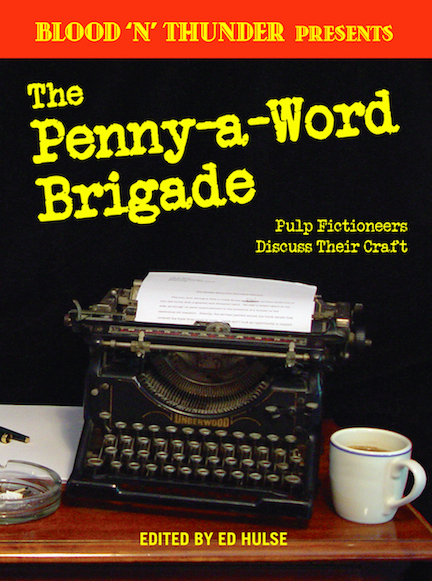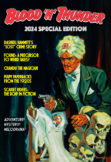EDitorial Comments
Now Available for Immediate Shipping: THE PENNY-A-WORD BRIGADE
The second volume of Blood ‘n’ Thunder Presents is now ready for immediate shipping. I’d hoped to debut it officially at last week’s PulpFest, but a printer snafu prevented me from getting copies to the show on time. The Penny-a-Word Brigade represents a departure for Murania Press in that it’s the first non-fiction book I’ve published that doesn’t contain any of my writing — except for the introduction, from which I quote below in explaining what the book’s all about.
From today’s vantage point, some 120 years after the first all-story, rough-paper magazine started a revolution in the publishing industry, the life of a pulp-fiction writer may appear more romantic than it actually was. There’s something quintessentially American about the scrappy entrepreneur laboring in solitude, relying on talent and initiative to achieve success in his chosen field against overwhelming odds. Viewed in that light, the pulp fictioneer of yore casts a lengthy shadow. If you admire those who make their living with words, it’s easy to find something admirable—perhaps even noble—about an earlier era’s ink-stained wretches, who endured privation for weeks, months, and even years before finally breaking into print.
Frank Gruber’s 1967 memoir, The Pulp Jungle, speaks of aspiring fiction writers getting evicted from their hotels or boarding houses, of long days spent making the rounds of Manhattan-based publishing houses, of haunting automats and subsisting on the only free meal available to penniless scribes—tomato soup improvised by drawing hot water in coffee cups, then adding ketchup and crackers from the dining tables. Born of necessity, this tactic was said to keep many a writer alive long enough to “click” with the right market. Then, once established, it was understood to be only a matter of time before he would rival Max Brand, H. Bedford-Jones, or Edgar Rice Burroughs. And after conquering the pulps, why, it wouldn’t be any time a-tall before he cracked the slick-paper periodicals—Collier’s, American, Red Book, The Saturday Evening Post—where one’s work attracted the attention of discriminating readers and, with any luck, editors from the prestigious houses publishing cloth-bound books. At least, that’s what the struggling storytellers dreamed as they gulped steaming mouthfuls of that tomato soup.
It was a tough grind, to be sure, but one that continued to attract hopefuls. Dewy-eyed aspirants were willing to serve an apprenticeship in the pulps, secure in the knowledge that raw talent and hard work would carry them to inevitable success in the slicks. And from there to—book sales! Newspaper syndication! Hollywood movie rights! These neophytes, eager for helpful tips and sage advice from the pulpwood Big Timers, poured over the pages of trade journals such as Writer’s Digest, Author & Journalist, Writer’s Review, and Writer’s Markets and Methods.
Established pulp writers and editors who contributed to these publications were surprisingly generous with advice and admonition both. Every now and then their articles were vague or self-serving, but a large number offered genuinely useful tips and outlined methods of working that are just as sound today as they were in 1930 or 1940. Indeed, although the rough-paper magazines themselves are long gone, many essays collected in this book will hold significant educational value for today’s wannabe writers.
A majority of the trade-journal pieces herein saw revival in issues of Blood ‘n’ Thunder. A few—specifically, those by hero-pulp legends Lester Dent, Norvell Page, and Walter B. Gibson—have been reprinted multiple times, but never all between two covers. In context, surrounded by similar articles from peers, each represents a vital piece in the larger puzzle.
Variety has been my watchword. I’ve mixed straight how-to articles with market analyses and personal reminiscences. Walter Gibson’s 1941 piece, celebrating his tenth anniversary as chief chronicler of The Shadow’s exploits, has a wealth of nostalgic detail but also some very sound advice for potential authors of single-character series. In addition to Gibson & Company, you’ll find contributions from such legendary high-volume producers as Arthur J. Burks, H. Bedford-Jones, and Erle Stanley Gardner along with many second-tier favorites, including Nelson Bond, Frederick C. Davis, G. T. Fleming-Roberts, Frank Gruber, and Henry Kuttner.
The blue-pencil boys also supplied guidance to followers of the writers’ magazines, and I’ve added excellent essays by Adventure‘s Arthur Sullivant Hoffman, Black Mask‘s Joseph T. “Cap” Shaw, and editorial directors of the major pulp outfits: Rogers Terrill (Popular Publications), Leo Margulies (the “Thrilling Group”), Robert A. W. Lowndes (Columbia/Double Action/Blue Ribbon), Ralph Daigh (Fawcett Publications), and Robert O. Erisman (Martin Goodman’s “Red Circle” line). Agents Lurton Blassingame and August Lenninger, frequent contributors to Writer’s Digest, present market reports that at the time of publication were considered valuable tools for newcomers aiming to crack well-established sheets.
One essay deserves a bit of explanation. “A Cent a Word,” bylined “Anonymous,” was first published in the February 1936 issue of American Mercury, a highbrow journal with limited circulation among the literary set. Vividly written and highly evocative of the period, it’s also an acidly cynical, unrelenting exercise in self-loathing. I find this piece a valuable counterpoint to the largely hopeful and encouraging submissions to the trade journals. It presents the dark side of pulp fictioneering and warrants close reading for purposes of balance.
Bottom line: Whether you’re a would-be fiction writer in the pulp tradition or a student of the pulp era and American popular culture, this book will make a great addition to your reference library.

Recent Posts
- Windy City Film Program: Day Two
- Windy City Pulp Show: Film Program
- Now Available: When Dracula Met Frankenstein
- Collectibles Section Update
- Mark Halegua (1953-2020), R.I.P.
Archives
- March 2023
- July 2021
- May 2021
- March 2020
- February 2020
- December 2019
- November 2019
- October 2019
- September 2019
- August 2019
- May 2019
- April 2019
- March 2019
- February 2019
- December 2018
- November 2018
- October 2018
- August 2018
- June 2018
- February 2018
- December 2017
- October 2017
- September 2017
- August 2017
- May 2017
- April 2017
- February 2017
- September 2016
- August 2016
- July 2016
- June 2016
- November 2015
- October 2015
- September 2015
- August 2015
- July 2015
- June 2015
- May 2015
- April 2015
- March 2015
- February 2015
- January 2015
- August 2014
- July 2014
- June 2014
- May 2014
- April 2014
- January 2014
- December 2013
- September 2013
- August 2013
- July 2013
- June 2013
- May 2013
- April 2013
- March 2013
- February 2013
- January 2013
- December 2012
- October 2012
- September 2012
- August 2012
- July 2012
- June 2012
- May 2012
Categories
- Birthday
- Blood 'n' Thunder
- Blood 'n' Thunder Presents
- Classic Pulp Reprints
- Collectibles For Sale
- Conventions
- Dime Novels
- Film Program
- Forgotten Classics of Pulp Fiction
- Movies
- Murania Press
- Pulp People
- PulpFest
- Pulps
- Reading Room
- Recently Read
- Serials
- Special Events
- Special Sale
- The Johnston McCulley Collection
- Uncategorized
- Upcoming Books
- Western Movies
- Windy City pulp convention
Dealers
Events
Publishers
Resources
- Coming Attractions
- Field Guide to Wild American Pulp Artists
- MagazineArt.Org
- Mystery*File
- ThePulp.Net




